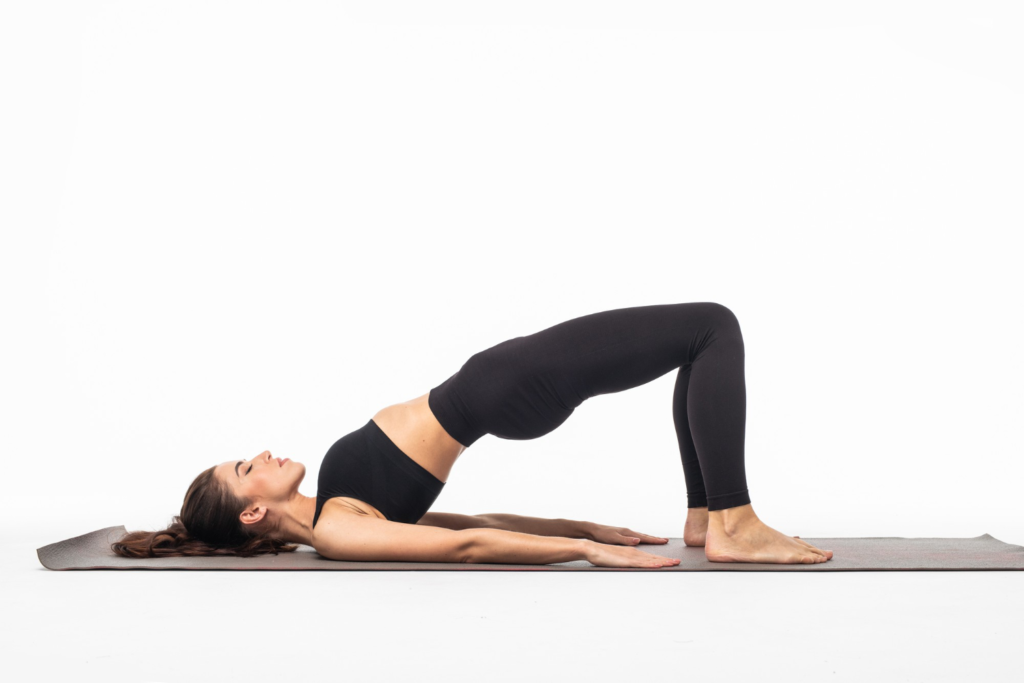The Bridge Pose, also known as Setu Bandha Sarvangasana in Sanskrit, is a powerful way to strengthen and open your body, providing numerous physical and mental benefits. In this blog post, we will explore the correct alignment, variations, and the incredible effects that Bridge Pose can have on your overall well-being.
Bridge Pose, or Setu Bandha Sarvangasana, is a backbend that targets the spine, chest, and hip flexors. The name “Setu Bandha Sarvangasana” is derived from the Sanskrit words “setu” meaning “bridge,” “bandha” meaning “lock,” “sarva” meaning “all,” and “angasana” meaning “pose.” This pose is often referred to as the “bridge” because it resembles the shape of a bridge.
Key Tips to Perform Bridge Pose
- To begin with Bridge Pose, lie on your back ,bend your knees and keep feet hip-width apart.
- Place your arms alongside your body, palms facing down.
- As you inhale, press your feet into the ground, engaging your glutes and lifting your hips off the mat.
- Adjust your thighs parallel to each other and make sure your knees are directly over your ankles.
- Interlace your fingers underneath your body and roll your shoulders underneath you, creating a gentle lift in your chest.
Physical Benefits of Bridge Pose
It offers a multitude of physical benefits that can enhance your overall well-being. Some of the key advantages are as belows:
a. Strengthens the back and core: It targets the muscles in the back, including the erector spinae, glutes, and hamstrings. Regular practice can help alleviate back pain and strengthen the core muscles, leading to improved posture and stability.
b. Opens the chest and shoulders: As you lift your chest in Bridge Pose, it stretches the chest and shoulders, counteracting the effects of hunching over a desk or computer. This can improve breathing capacity and alleviate tension in the upper body.
c. Stimulates the thyroid gland: The gentle compression of the throat in this pose stimulates the thyroid gland, which plays a crucial role in regulating metabolism and energy levels.
d. Relieves stress and anxiety: It is known for its calming effect on the nervous system. The gentle backbend stimulates the parasympathetic nervous system, promoting relaxation and reducing stress and anxiety.
Mental benefits of practicing Bridge Pose
Practicing it offers several mental benefits that can contribute to your overall well-being. Here are some of the key mental advantages:
- Stress reduction: It is known for its calming effect on the nervous system. The gentle backbend stimulates the parasympathetic nervous system, which promotes relaxation and reduces stress levels. By practicing this pose regularly, you can find relief from the pressures of daily life and cultivate a sense of inner calm.
- Anxiety relief: It can help alleviate anxiety by activating the relaxation response in the body. As you lift your chest and open your heart in this pose, it creates a sense of expansion and release, allowing you to let go of tension and worry. The deep breathing associated with the pose also helps to calm the mind and bring a sense of tranquility.
- Mood enhancement: The physical movement and opening of the chest in Bridge Pose can have a positive impact on your mood. This pose stimulates the release of endorphins, which are natural mood-boosting hormones. Regular practice can help uplift your spirits, increase feelings of happiness, and combat feelings of depression.
- Increased self-confidence: It encourages a sense of empowerment and self-assurance. As you lift your hips and open your chest, you are physically expanding and creating space within your body. This can translate to a boost in self-confidence and a greater sense of self-worth.
- Improved focus and concentration: The practice of Bridge Pose requires concentration and mindful awareness of the body. By focusing on the alignment and sensations in the pose, you can cultivate a sense of presence and improve your ability to concentrate. This enhanced focus can carry over into other areas of your life, helping you to stay more present and engaged.
- Emotional balance: It can help bring balance to your emotions. By opening the chest and releasing tension in the body, you create space for emotions to flow more freely. This can lead to a greater sense of emotional well-being and the ability to navigate and process emotions more effectively.
Incorporating it into your yoga practice can provide a holistic approach to mental well-being, promoting relaxation, reducing stress and anxiety, enhancing mood, boosting self-confidence, improving focus, and fostering emotional balance. Remember to approach the pose with mindfulness and listen to your body’s needs as you explore its mental benefits.
Variations of Bridge Pose
Bridge Pose can be modified to suit different levels of flexibility and strength. Here are a few variations you can explore:
a. Supported Bridge Pose: Place a block or bolster under your sacrum to provide support and deepen the stretch.
b. One-Legged Bridge Pose: Lift one leg off the ground, extending it towards the ceiling while maintaining the bridge position with the other leg. This variation increases the challenge and strengthens the glutes and hamstrings.
c. Wheel Pose (Chakrasana): For advanced practitioners, Wheel Pose is an intense backbend that takes Bridge Pose to the next level. This pose requires significant flexibility and strength in the back, shoulders, and arms.
Bridge Pose, or Setu Bandha Sarvangasana, is a transformative yoga posture that offers a wide range of physical and mental benefits. Regular practice of this pose can strengthen the back, open the chest, and relieve stress and anxiety. Remember to always listen to your body and change the pose as needed. Incorporate Bridge Pose into your yoga routine and experience the positive impact it can have on your overall well-being.
Frequently Asked Questions:
What is Bridge Pose good for?
1. Strengthens the back and core
2. Opens the chest and shoulders
3. Stimulates the thyroid gland
4. Relieves stress and anxiety
5. Improved focus and concentration

